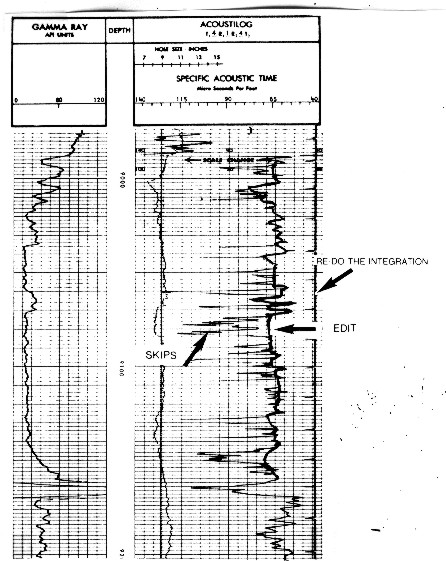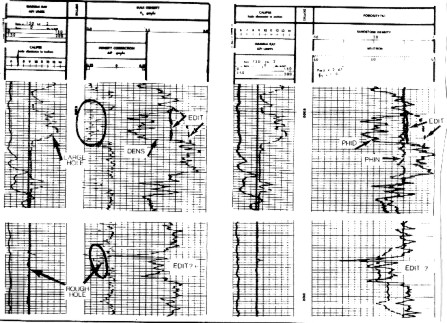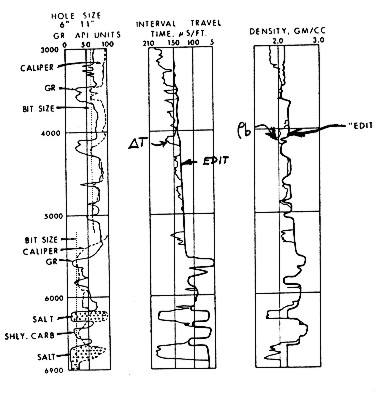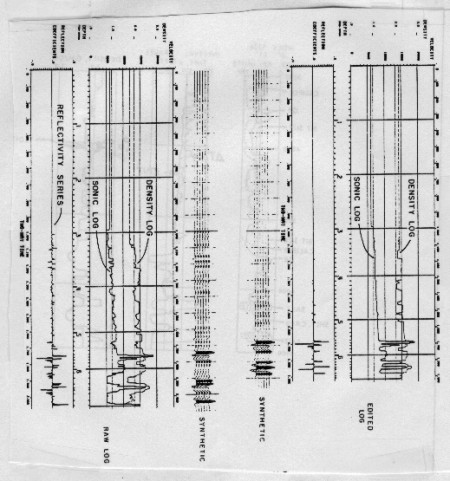|
 Editing the Sonic and Density Logs With Trend Data
Editing the Sonic and Density Logs With Trend Data
Sonic and density logs often contain "noise" or spikes caused by
tool malfunction or bad hole effects. If the trend of the log is
discernable, we merely trim off the spikes and digitize the log,
as in the two illustrations below.

Editing sonic with trend analysis

Editing density with trend analysis
NOTE: When the integration tics on a sonic log are being used,
and edits are needed, the integration must also be re-done. This
is true after ANY editing method has been applied.
When
longer intervals are noisy, it may not be possible to identify
the background log. It is common to refer to offset wells, where
some logs may be better quality, and use the general trend of
log values as a guide to editing. A method suggested by Brian
Ausburn in 1977 recommended the preparation of composite sonic
versus depth and density versus depth graphs from a number of
wells. By choosing only data that did not suffer from noise, the
graph could indicate the value to use during an edit of a noisy
log.
Separate graphs for shales, sandstones, and carbonates are made
and used based on known or assumed lithology. Since the gamma
ray log is not strongly affected by bad hole, it is used to
differentiate shales from other rocks. Generalized geological
knowledge is used to differentiate sandstones from carbonates.
Since porosity in carbonates does not vary linearly with depth
like sandstone does, trend lines for carbonates might not be
very useful.
If
evaporites such as coal, salt, anhydrite, or potash minerals are
present, correct values for these minerals are known and can be
inserted (see table below).
 Case History
- Editing with Trend Data
Case History
- Editing with Trend Data
This example presents a severe, but plausible, simulated editing
situation for a seismic modeling job. This example is taken from
"Log Editing in Support of Detailed Seismic Studies",
by Brian E. Ausburn, SPWLA, 1977. A brief excerpt of his paper
discusses the editing process as follows:

Original and edited logs
Interval
3000 - 5520: a sand/shale sequence, most shales are washed out,
yet the majority of sands remain in gauge. The combination of
hole enlargement and shale alterations results in apparent shale
velocities and densities lower than actual formation values.
This
judgment is often based on trend curves developed from other wells
in the area, where hole conditions for the equivalent stratigraphic
section are superior. In this simulated example, the correction
trend is substantiated by observed shale velocity values in sections
where the hole has no wash out, as at 4960-5220 and 5370-5220.
If
a mechanical reason for hole washout cannot be determined, the
substitution value should be considered carefully. It is possible
the zone washed out because it is different from the nearby equivalent
zones.
Shale
alterations and washouts also affect the density log. Hole problems
can be subdivided into rugosity and enlargements. Rugosity is
sufficient to cause density log errors with little hole enlargement.
Both are corrected by applying modeling techniques described later.
Interval
5520-6900: a mixed section of limestone, sandstone, shale and
salt. With the exception of a few obvious hole washouts noted
on the caliper in shale sections, the majority of editing is related
to the salt section.
Note
that the density log has been edited from 6790-6900 even though
the hole is in gauge throughout that section. Due to a different
electron/bulk density relationship for salt, from most other sedimentary
rocks, the apparent log bulk density of salt is not the true bulk
density. By contrast, the sonic response in the good hole salt
section substantiates the validity of the sonic edits in the washed
out salts.
The
example below compares synthetic seismograms that would be obtained from
raw and edited log data. As predicted from the severity of edits
shown above, the differences in synthetic seismograms
are significant.

Synthetic seismogram before and after editing
Note
that the shallow section of the synthetic from unedited data has
more character than from edited data. These apparent events represent
only the observed contrasts in the erroneous information and not
any real acoustic impedance contrast in the subsurface.
The
last major event from the unedited set occurs at approximately
2.030 seconds, while on the edited version this event occurs at
approximately 1.875 seconds. This difference reflects the significance
of the uphole velocity in achieving depth/time ties between seismic
and wellbore data. In this case, the too slow velocity observed
on the uphole portion of the raw log could make a difference of
500 to 1,000 feet in the location of the deeper events. Raw log
data generally makes a synthetic too long, but invasion in gas
zones and vuggy porosity can make it too short.
|

